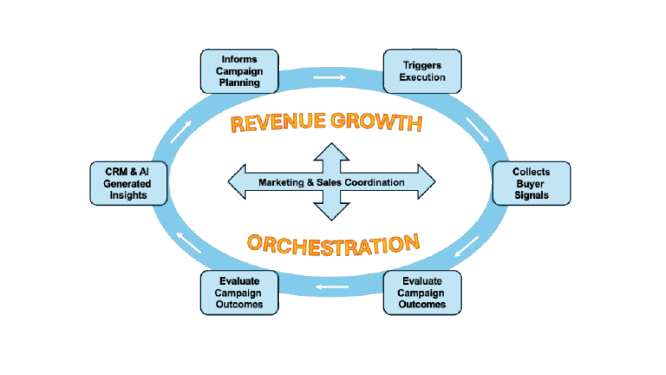Fragmentation to Coordination
Given the pace of generative AI's evolution — and the fervor surrounding its potential — you might expect B2B companies to be far along in their implementation efforts.
But the truth is, especially in the mid-market, most are just beginning to explore how AI can integrate with their existing MarTech and SalesTech stacks — let alone orchestrate consistent, coordinated revenue execution. That gap between promise and practice is exactly where the opportunity lies.
In our recent Messaging Machines + congruentX roundtable — "AI + CRM: Orchestrating Revenue — Moving Beyond Tasks to Predictable Growth" — we gathered B2B leaders across marketing, sales, RevOps, and academia to explore what orchestration means, why most companies aren't doing it yet, and how to begin. Our panelists included Andrew Dietz from Messaging Machines, Chuck Ingram from congruentX, David Schweidel from Emory University's Goizueta Business School, and Michael Rodriguez from East Carolina University's Twilley Academy of Sales Leadership.
Here's a summary of the discussion.
The Tools Aren't the Problem. The Coordination Is.
Most B2B teams today have a CRM in place. Many are experimenting with generative AI tools. But these systems often live in silos, and they're rarely used to support shared sales and marketing execution.
The culprit is a fragmentation of both technology and behavior.
“If your tools aren't changing how your teams behave or how your buyers respond, you're not orchestrating — you're just experimenting.” — Andrew Dietz, Messaging Machines
The opportunity ahead isn't just plugging AI into more workflows. It's designing revenue systems where AI and CRM reinforce how people work together, not separately.
What Orchestration Looks Like
At the event, we described a modern go-to-market system where orchestration connects strategy, AI, CRM, and real-time feedback in one adaptive loop.
This system aligns personas, messaging, campaign execution, content delivery, CRM data, and buyer signals — all enhanced by generative AI and coordinated across teams.
In an orchestrated setup:
Generative AI helps teams act at the right time with the right message
CRM becomes the place where actions are triggered and tracked
Sales and marketing execute from the same strategy and coordinated tactics, not separate playbooks
Classic GTM vs. Orchestrated GTM
The difference between traditional go-to-market execution and orchestration can be striking.
In the traditional model, execution is fragmented. Teams work from different timelines, tools, and assumptions. Marketing produces content and campaigns to attract broad groups of prospects. The Sales team handles direct outreach to individual prospects. But the two don't always meet in the middle.
In an orchestrated system, marketing and sales plan, time, and measure those elements in sync. AI helps bridge gaps in personalization, timing, and insight. CRM ensures nothing falls through the cracks.
This approach isn't necessarily about more tech. It's about building systems that connect people, platforms, and decisions across the revenue engine.
What Early Wins Are Telling Us
We're still early in the orchestration curve, but companies taking even small, coordinated steps are already seeing results.
At Honeywell, the marketing team used generative AI to unify previously disconnected vertical campaigns and align marketing messaging with CRM-driven sales outreach. The result?
A 4x increase in pipeline creation
Improved lead conversion
Faster execution and better alignment across teams
"They didn't just create more content. They restructured how marketing and sales worked together — with shared inputs, coordinated timing, and measurable outcomes." — Andrew Dietz
Signs You're Not Orchestrating Yet
Most companies aren't orchestrating yet — and that's OK. But there are clear signals it's time to start:
CRM is a data bucket, not a decision platform
AI is being used individually, not organizationally.
Sales and marketing don't share a clear definition of "lead readiness"
Campaigns run, but there's little insight into what actually moved the needle
"If you're not hearing common language around shared signals, you're not orchestrating." — Chuck Ingram, CEO, CongruentX
Get an Orchestration Jump Start
You don't need to overhaul your entire go-to-market system. Start with one coordination gap — a place where handoffs break, follow-up is inconsistent, or teams aren't acting on the same signals.
Here's how:
1. Identify one revenue "breakpoint" where coordination breaks down
2. Design a shared play across marketing and sales to address it
3. Use AI and CRM to trigger, execute, and track the play
4. Run it as a 90-day orchestration sprint
5. Learn, refine, and expand
"The smartest AI investment isn't in more features — it's in one shared execution system that works and scales." — Michael Rodriguez, East Carolina University
Let's Build Your First Orchestrated Play
At Messaging Machines, we help B2B companies move from disconnected tools to integrated, orchestrated revenue execution.
Want to explore your orchestration opportunity? Reach out at Andrew @ messagingmachines.com
Or dig deeper into www.messagingmachines.com


